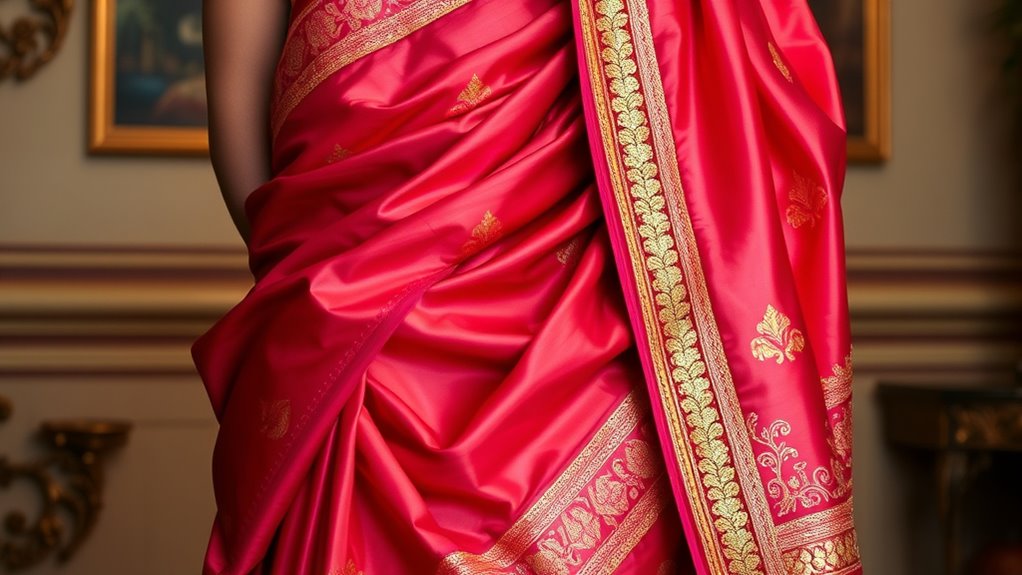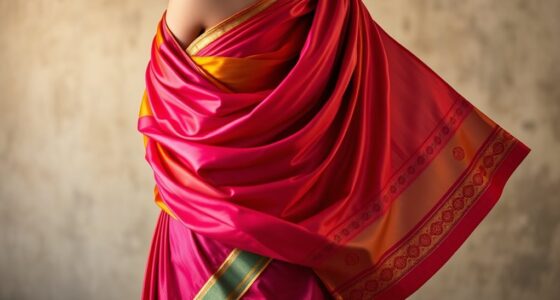Discover the complete guide to Indian saree draping styles, from traditional methods like the classic Nivi, Bengali, Gujarati, and Maharashtrian styles, to regional and festive variations such as the Nauvari and Butterfly styles. You’ll also explore contemporary drapes like belt, cape, and dhoti styles that suit modern tastes. Each style reflects regional culture, occasion, and personal expression. Keep exploring to master these elegant draping techniques and elevate your saree wardrobe effortlessly.
Key Takeaways
- Covers traditional styles like Nivi, Bengali, Gujarati, Maharashtrian, and Nauvari, highlighting unique draping techniques and regional influences.
- Details modern and contemporary saree styles such as Belted, Cape, Dhoti, Pant, and Half Saree for casual and festive occasions.
- Offers tips on fabric selection, accessory pairing, and fabric textures to achieve elegant, culturally rich looks.
- Explains the Butterfly style and festive draping methods for special celebrations and vibrant appearances.
- Provides guidance on maintaining style neatness, securing pleats, and choosing suitable embellishments for different events.
The Classic Nivi Style
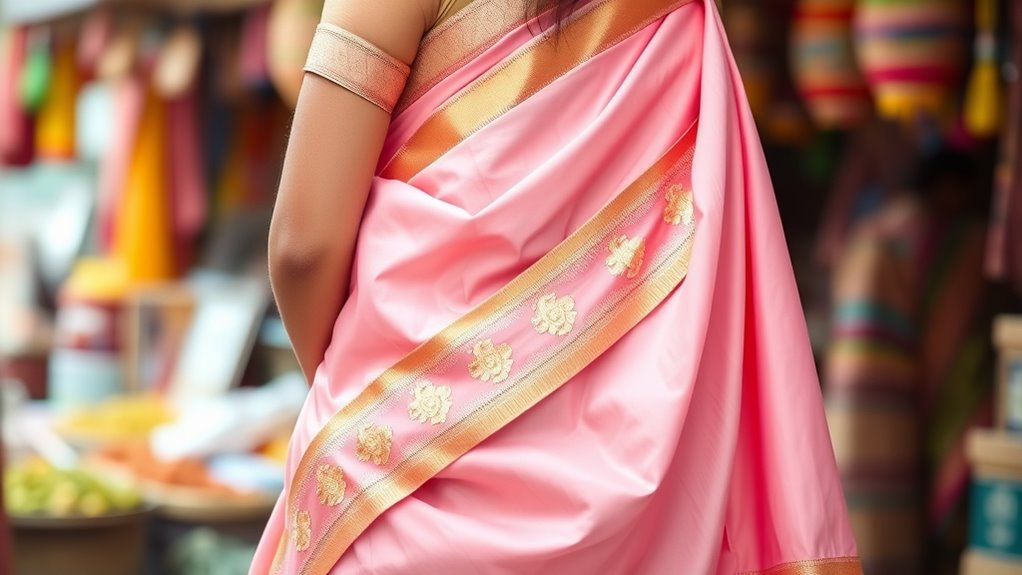
The Classic Nivi Style is the most popular and widely recognized way to drape a saree in India. You can choose from various fabric choices like silk, georgette, chiffon, or cotton, depending on your occasion and comfort. The drape highlights the fabric’s texture and enhances your overall look. When it comes to accessory pairing, keep it simple yet elegant—classic jewelry like jhumkas, bangles, and a statement necklace work beautifully. Your blouse style and petticoat color should complement the saree fabric to create a cohesive appearance. Remember, the key to this style is neat pleats and a secure pallu drape, which allows for ease of movement and a polished look. With the right fabric and accessories, you’ll effortlessly achieve timeless elegance.
The Bengali Style

Ever wondered how Bengali women showcase their cultural pride through saree draping? The Bengali style emphasizes elegance and tradition, often highlighting the saree’s fabric textures and cultural symbolism. You typically drape the saree in a simple, neat way, with the pallu draped over the shoulder, showcasing intricate designs. The style often involves a longer pleat at the front, allowing the pallu to fall gracefully. Bright colors and rich fabrics like silk or tussar are preferred, reflecting regional craftsmanship. This draping style is perfect for festivals and cultural celebrations, emphasizing the saree’s heritage. Incorporating traditional vintage decor elements into accessories can further enhance the cultural symbolism of the look.
The Gujarati Style

Gujarati women often drape their sarees in a way that celebrates regional vibrancy and craftsmanship. This style is characterized by the unique way the saree is pleated and tucked, creating a graceful silhouette. You’ll notice fabric variations like silk, chiffon, and georgette, each adding a different texture and elegance to your look. Regional influences play a significant role, with vibrant colors and intricate borders reflecting Gujarat’s rich cultural heritage. The Gujarati style typically involves pleating the saree in the front and draping the pallu over the shoulder, often with a brooch or embellishment to highlight the look. This draping method emphasizes comfort and allows the fabric’s beauty to shine, making it perfect for festivals and celebrations.
The Maharashtrian Style (Kashta)
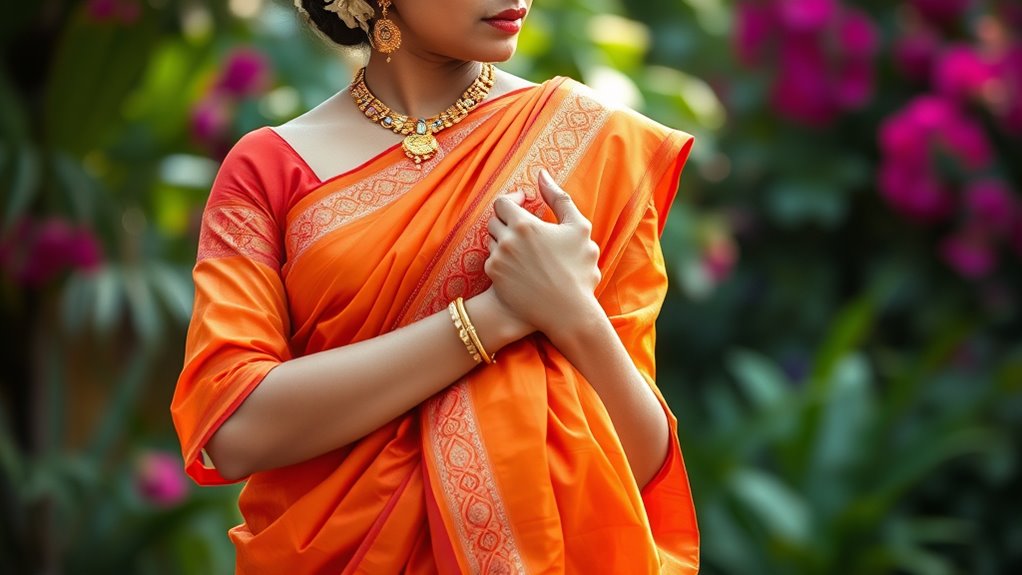
Maharashtrian women often choose the Kashta style to showcase elegance and cultural pride. This draping style highlights traditional aesthetics, influenced by regional customs and history. You’ll notice fabric choices like silk and cotton, which add richness and comfort, reflecting cultural influences. The Kashta style involves pleating the saree neatly and draping it over the shoulder, often with a decorative waistband. It’s ideal for festivals, religious events, or formal gatherings where tradition shines. The style emphasizes simplicity with a regal touch, making it perfect for those who want to honor heritage. This draping method also allows for easy movement and comfort during long celebrations.
The Maharashtrian Nauvari Style
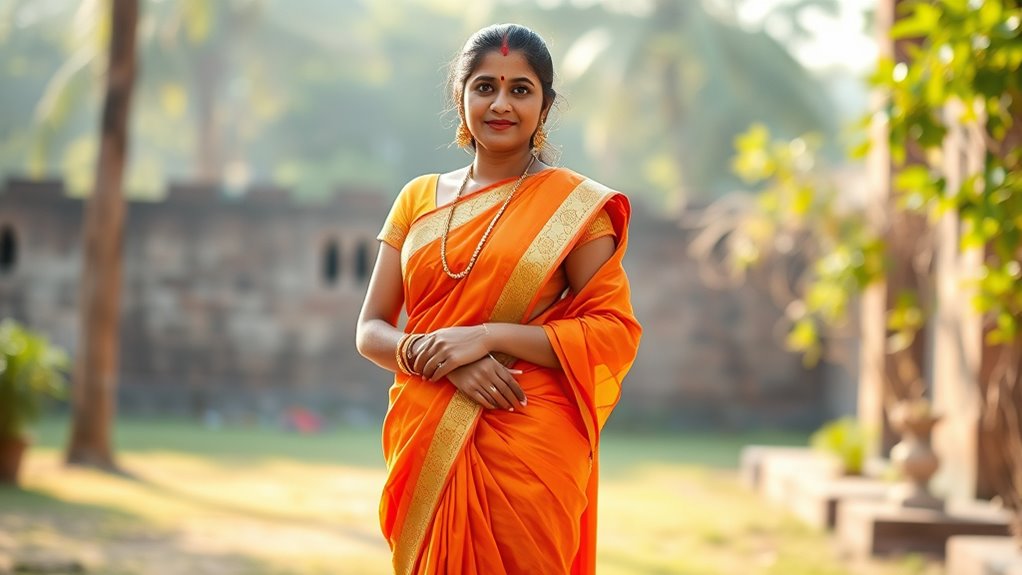
The Maharashtrian Nauvari style has deep historical roots and symbolizes tradition and strength. Its unique draping technique allows for ease of movement, making it ideal for festivals and cultural events. You’ll also find it paired with specific accessories that enhance its regal and practical appeal. Additionally, the style embodies spiritual energy, reflecting cultural reverence and communal harmony.
Historical Significance and Origins
Because of its practicality and ease of movement, the Nauvari style has deep historical roots in Maharashtra’s culture. It’s believed to date back to ancient times, often associated with warrior women and the Maratha empire. The style embodies cultural symbolism, representing strength, independence, and regional pride. Over centuries, it has evolved with regional variations, reflecting local traditions and climate. The Nauvari’s origins are linked to the traditional attire worn during battles, allowing flexibility and comfort. Its historical significance also highlights the role of women in Maharashtra’s history, especially during the Maratha era. Today, the style remains a powerful symbol of cultural identity and heritage, connecting modern women to their rich past. Additionally, best vacuums for hardwood floors are essential for maintaining the cleanliness of traditional spaces where saree draping is common, ensuring a tidy environment for cultural celebrations.
Draping Technique and Style
Draping the Nauvari saree involves a distinctive technique that emphasizes both functionality and elegance. You start by wrapping the saree around your waist and making precise saree pleats, ensuring they are tight and symmetrical. Unlike other styles, the Nauvari drape resembles a dhoti, with the fabric tucked securely at the back and tucked again between the legs, allowing free movement. This style often uses draping accessories like a traditional waistband or hooks to keep everything in place. The pleats are carefully arranged to create a neat, layered look that stays secure without additional pins. Mastering this draping technique requires practice, but it offers a regal, traditional appearance that highlights the saree’s versatility and the Maharashtrian culture. Proper color accuracy in the fabric and accessories enhances the overall elegance of the drape, making it even more striking.
Suitable Occasions and Accessories
Wearing the Maharashtrian Nauvari saree is perfect for special occasions that call for traditional elegance, such as festivals, weddings, and cultural celebrations. Its distinctive drape and rich history make it ideal for highlighting cultural pride. While it’s primarily reserved for festive and formal events, you can also style it for casual wear or even office attire when paired with simple accessories and a neat blouse. To complete your look, consider using traditional jewelry like a nath or earrings, a waist belt, and a jasmine garland. Keep accessories minimal for a more contemporary vibe or go bold for a festive appeal. This saree’s versatility allows you to blend tradition with modernity effortlessly. Additionally, understanding the key components of sound design can inspire creative ways to enhance cultural presentations or performances featuring traditional attire.
The South Indian Style (Madisar)
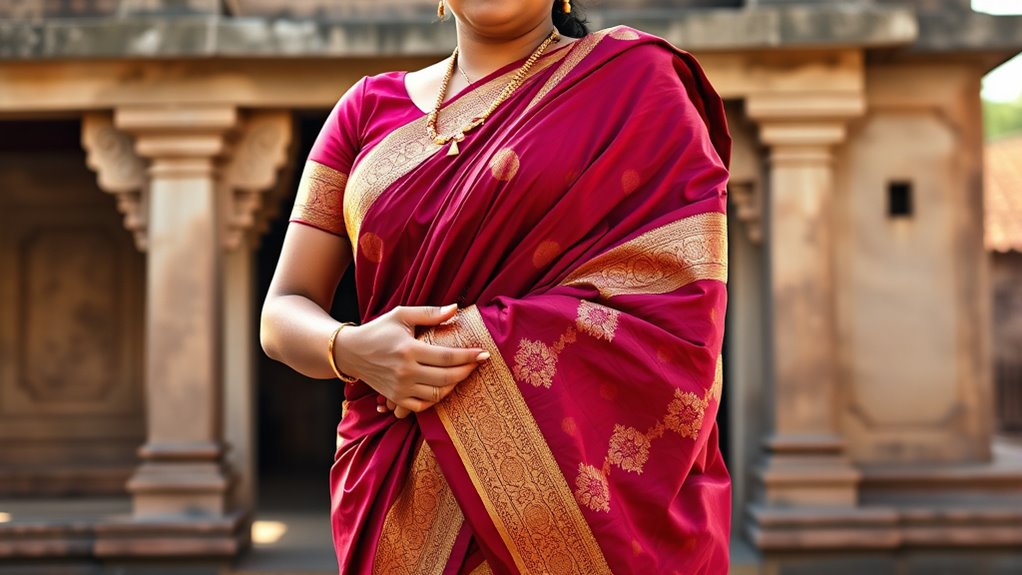
The South Indian style, known as Madisar, is a traditional method of draping a saree that holds cultural and religious significance, especially among Tamil Brahmins. You choose fabric carefully, often opting for cotton or silk, reflecting the importance of cultural traditions. This style involves wrapping the saree in a unique manner, symbolizing respect and devotion. Madisar is versatile and comfortable once mastered, suited for religious ceremonies and family gatherings.
| Aspect | Details |
|---|---|
| Fabric Selection | Cotton, silk, lightweight for comfort |
| Cultural Significance | Symbolizes tradition, respect, and devotion |
| Draping Method | Wraps around waist, between legs, over shoulder |
| Occasion | Religious rites, festivals, special ceremonies |
The Butterfly Style
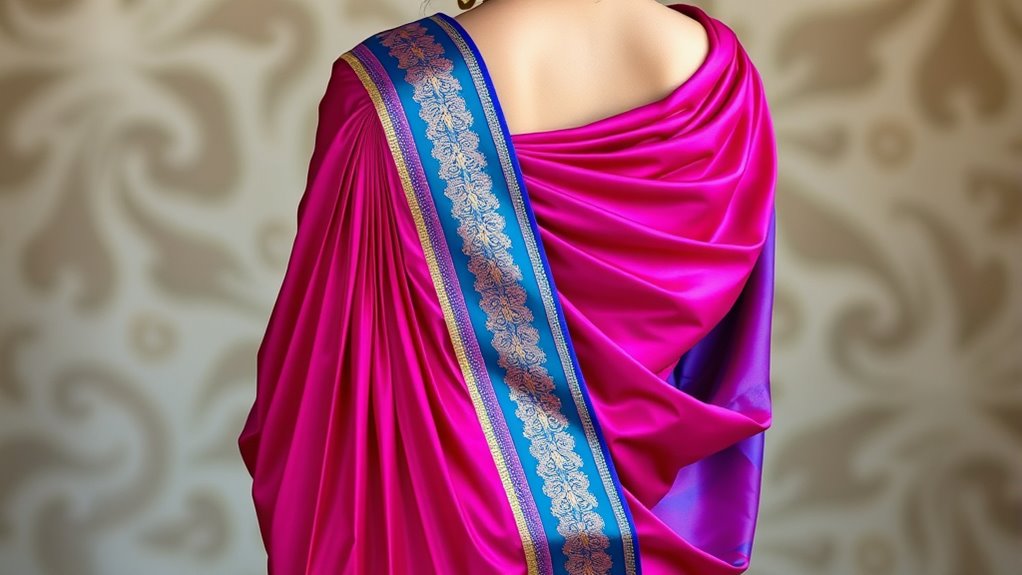
The Butterfly Style gives you an elegant winged look that instantly grabs attention. It’s perfect for festive occasions when you want to stand out beautifully. With its graceful drape, this style adds a touch of charm to any celebration. To maintain the style and ensure the saree stays flawless, using self-watering plant pots as a metaphor for proper support and balance can be surprisingly helpful.
Elegant Winged Look
To achieve the elegant winged look, you start by draping the saree smoothly around your waist, ensuring the pleats are neat and aligned. This style creates the appearance of delicate wings on either side of your waist, adding a graceful touch. Focus on selecting the right fabric choices; lightweight silks or chiffon work best for fluid movement. Embellishment ideas like subtle embroidery or mirror work can enhance the look without overwhelming it. Keep the pleats crisp for a polished finish, and secure the pallu with pins to maintain the winged effect. This style is perfect for making a refined statement at formal events or sophisticated gatherings.
- Choose lightweight fabrics like chiffon or silk
- Incorporate subtle embellishments for elegance
- Keep pleats neat and aligned
- Use pins to secure the winged sides
- Opt for minimalistic jewelry to complement the style
Perfect for Festivities
Building on the elegance of the winged look, the Butterfly Style elevates your saree for festive occasions with vibrant, eye-catching details. Choose a saree fabric that reflects the celebration—silk, brocade, or embellished fabrics work beautifully. Pay attention to color coordination; opt for bold, contrasting hues or harmonious shades that enhance your overall look. This draping style showcases intricate pleats and a unique pallu arrangement, making it perfect for lively festivities. Adding statement jewelry and vibrant accessories complements the style further. The Butterfly Style’s dynamic silhouette captures attention and radiates joy, making you stand out at any celebration. With the right fabric and color choices, this draping style transforms your saree into a festive masterpiece. Additionally, incorporating spiritual decor elements can create a harmonious and positive ambiance that enhances your festive appearance.
The Contemporary Drapes for Modern Occasions
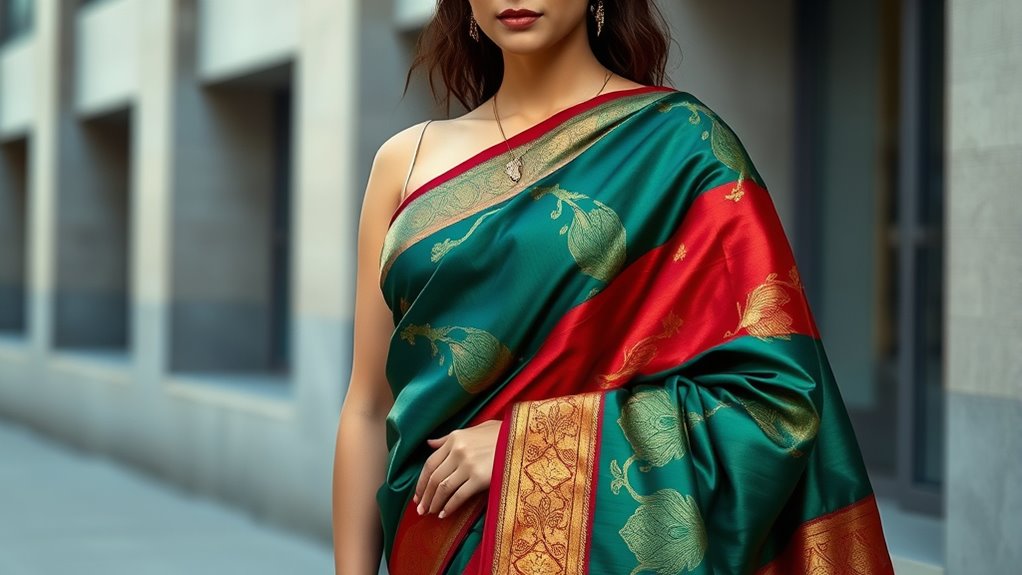
As contemporary fashion evolves, modern saree draping styles have gained popularity for their chic and versatile appeal. These styles are perfect for modern occasions, blending traditional elegance with current trends. You can experiment with sustainable fabrics like organic cotton or hemp to make a statement about eco-conscious fashion. Incorporating backyard greenhouses into your lifestyle can inspire eco-friendly choices in your wardrobe and home decor. Pair your saree with minimalist accessories to keep the look sleek and sophisticated. Some popular contemporary drapes include the Belted Saree, Cape Saree, Dhoti Style, Pant Style, and the Half Saree. These styles offer comfort and a fresh look, making them suitable for cocktail parties, exhibitions, or casual gatherings. Embrace these innovative draping techniques to stand out and express your unique style effortlessly.
Frequently Asked Questions
Which Saree Draping Style Suits Petite Body Types Best?
They say, “Fit is everything,” and that’s true for petite body types. When choosing saree draping techniques, opt for styles like the butterfly or Gujarati drape that highlight your frame without overwhelming it. These styles create a balanced look and enhance your natural grace. Keep it simple yet elegant, focusing on neat pleats and tailored drapes that complement your petite stature perfectly.
How to Choose the Right Blouse for Each Draping Style?
When choosing the right blouse for each draping style, consider the blouse fabric and sleeve designs. You want a fabric that complements your saree and enhances your overall look. For elegant drapes, opt for silk or brocade, while lightweight fabrics like chiffon work well for casual styles. Sleeve designs, from sleeveless to long sleeves, should match your personal style and the occasion, ensuring comfort and flair with every drape.
Are There Specific Saree Fabrics Recommended for Hot Climates?
If you’re dressing for hot climates, opt for lightweight, breathable saree fabrics like cotton, linen, or chiffon. These materials offer good saree fabric durability and keep you cool. Look for eco-friendly saree materials to stay environmentally conscious while ensuring comfort. These fabrics are perfect for staying fresh and comfortable in the heat, making your saree-wearing experience enjoyable without sacrificing style or sustainability.
Can Saree Draping Styles Be Adapted for Maternity Wear?
You can definitely adapt saree draping styles for maternity wear to stay comfortable. Maternity saree draping offers comfortable saree styles that allow ease of movement and support your growing belly. For instance, you might prefer a less pleated, more relaxed drape or use stretch fabrics. By customizing traditional styles, you can look elegant while ensuring comfort. So, yes, maternity saree draping helps you stay stylish and comfortable throughout your pregnancy.
What Accessories Complement Each Traditional Draping Style?
You want to know what accessories complement each traditional draping style. Focus on jewelry pairing—delicate necklaces, jhumkas, and bangles enhance your look, while statement earrings suit some styles better. Footwear choices matter too; opt for embellished sandals or kolhapuris for comfort and elegance. Keep your accessories balanced to highlight your saree’s beauty, ensuring your outfit is cohesive and stylish, no matter the draping style you choose.
Conclusion
Now that you’ve explored these diverse saree draping styles, you’re ready to embrace tradition or make a modern statement. Whether you choose the timeless elegance of the Nivi or the bold flair of the Butterfly style, each drape tells a story. It’s a perfect blend of history and innovation—classic grace meeting contemporary fashion. So, step into your wardrobe with confidence, knowing you can effortlessly switch from tradition to trend in a single saree.
